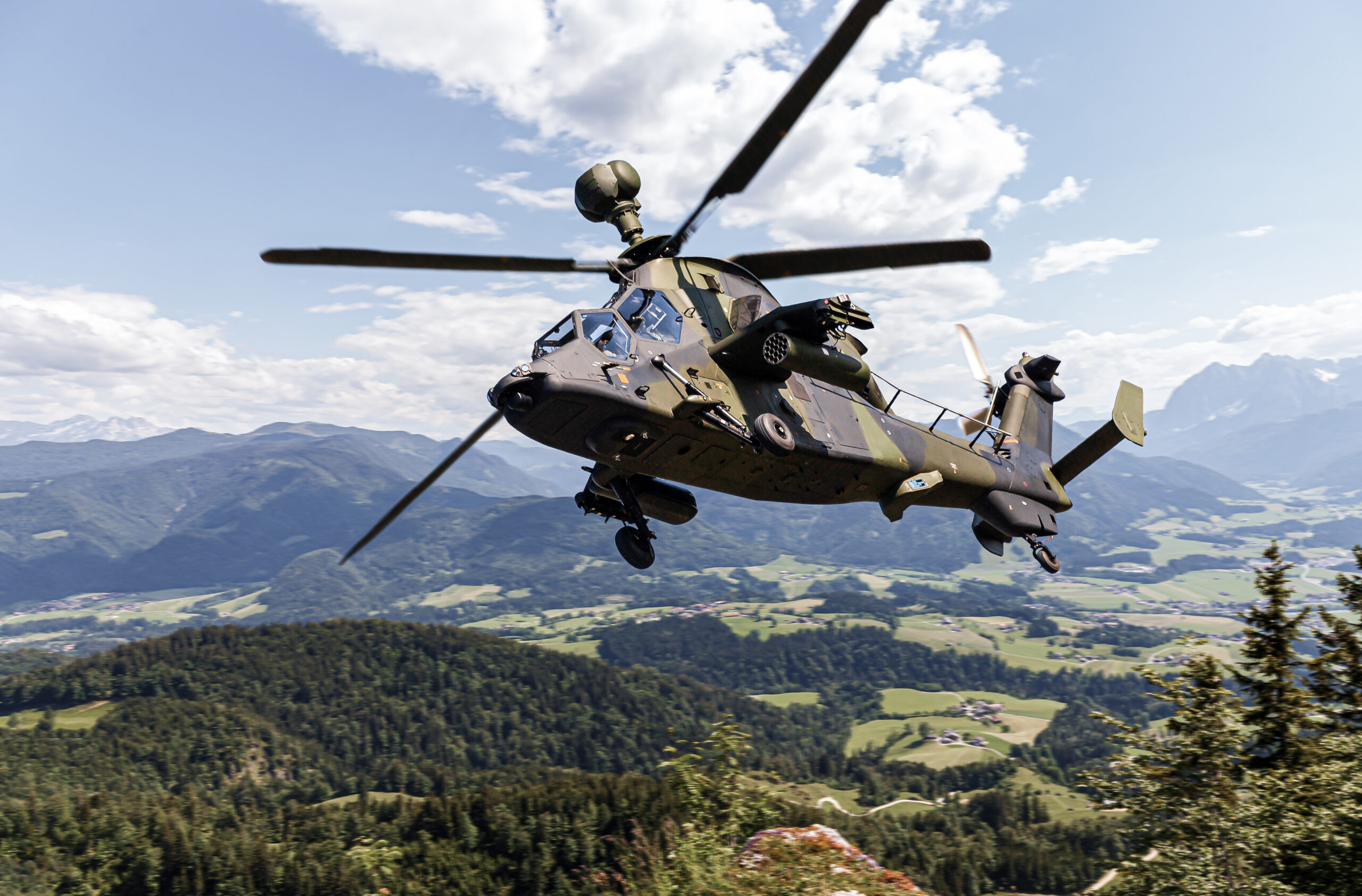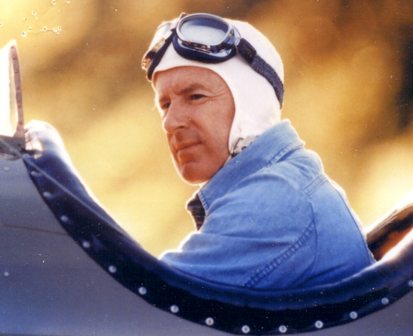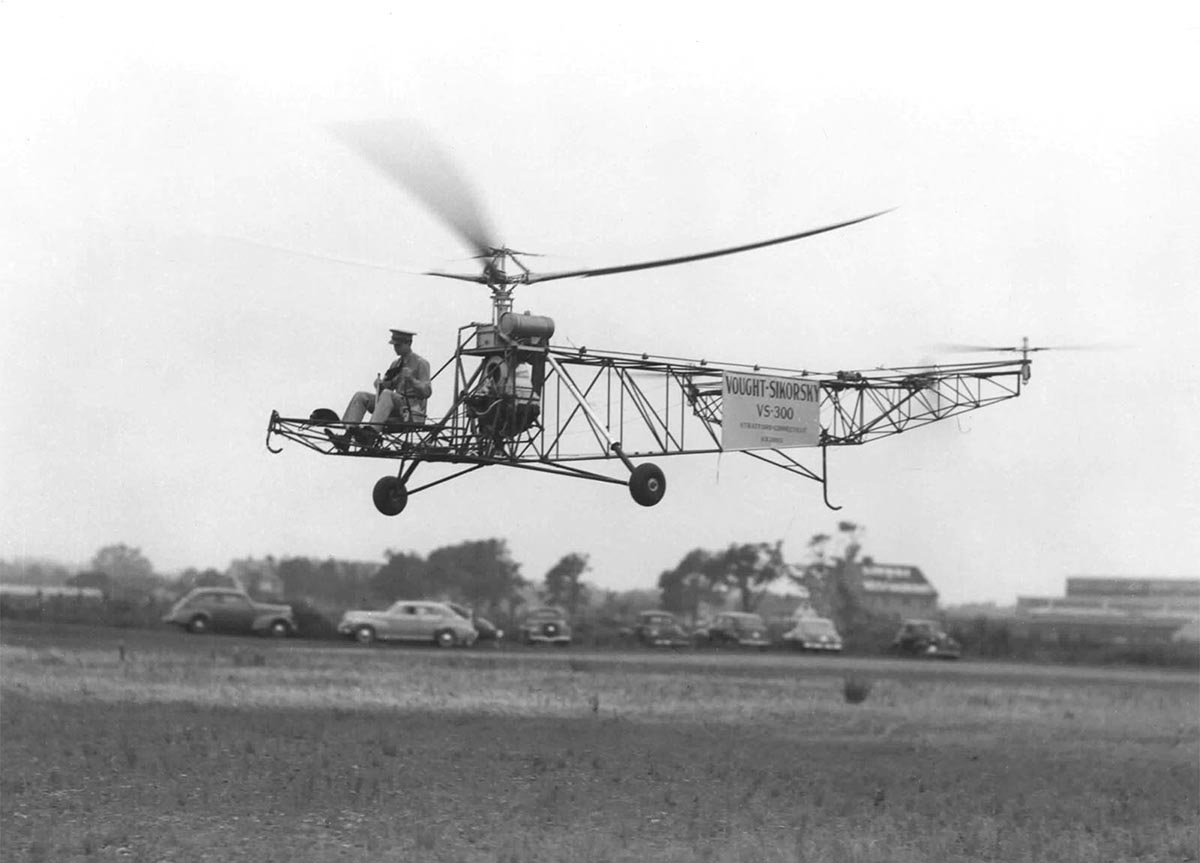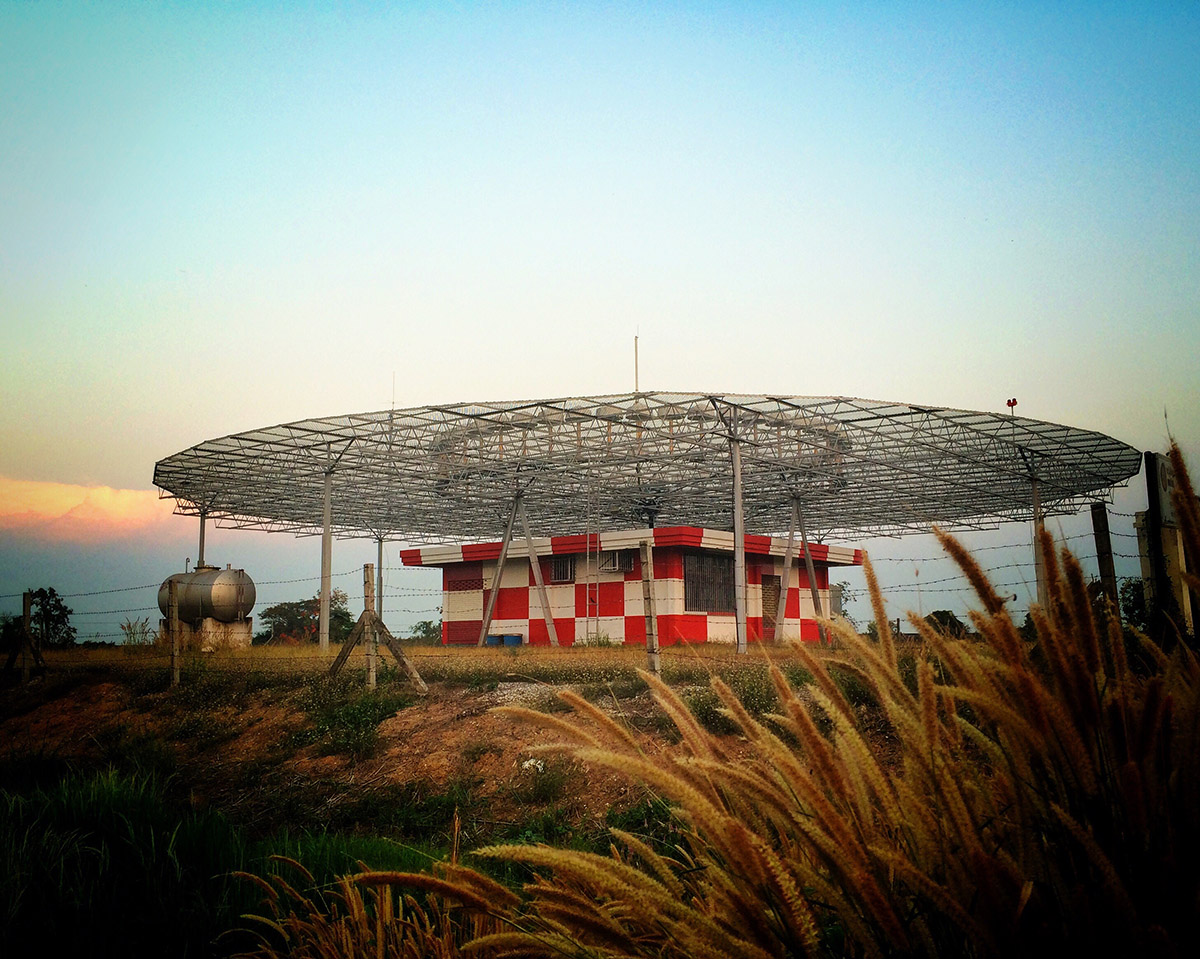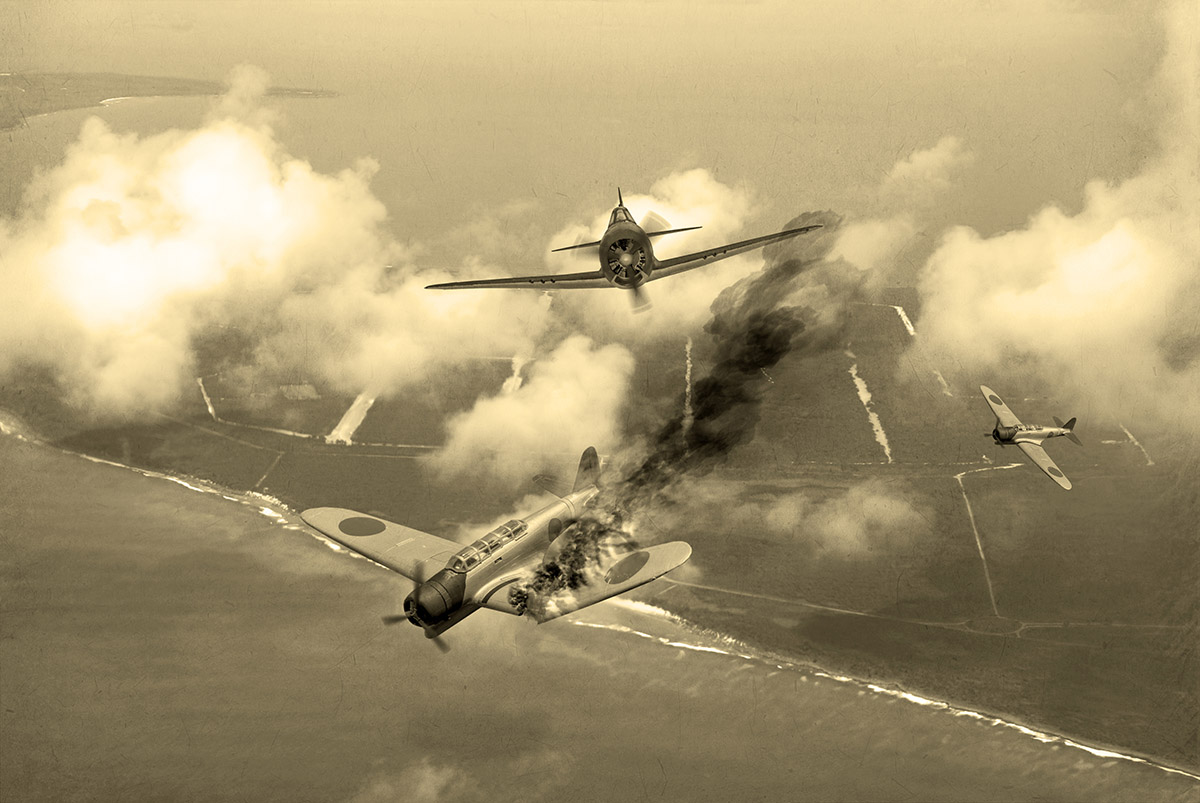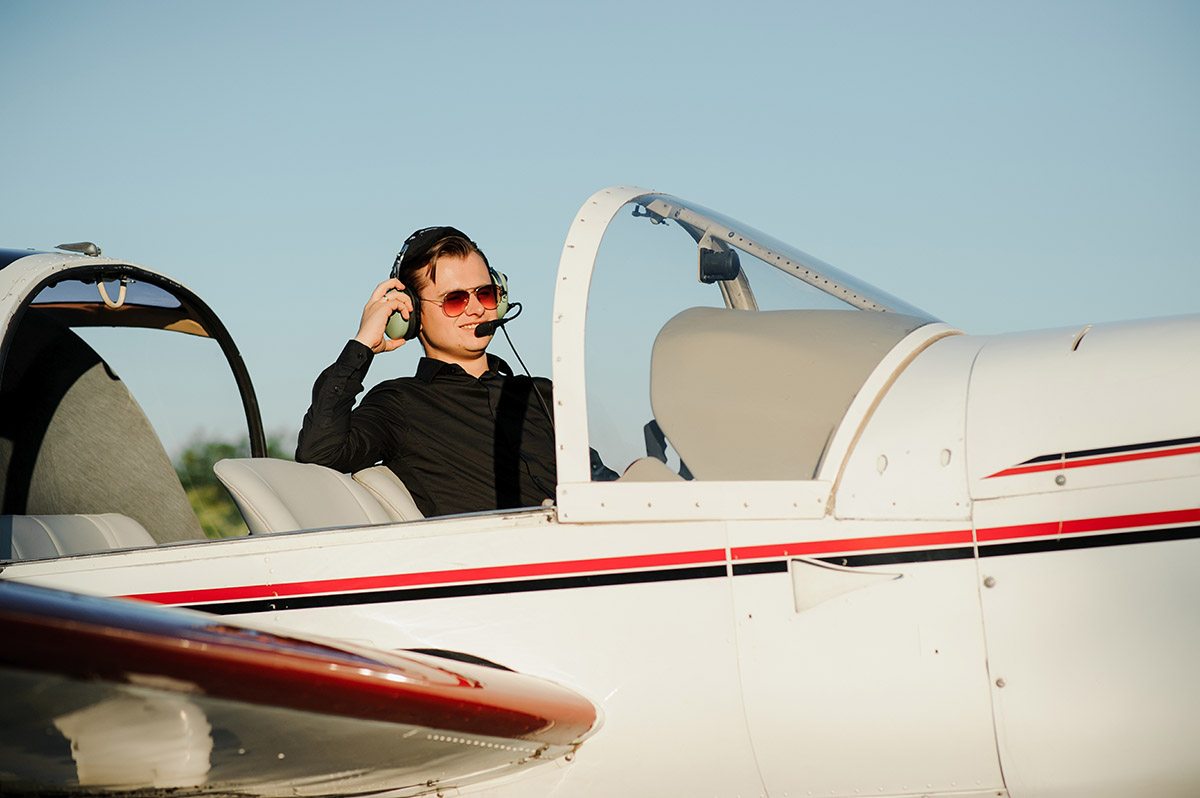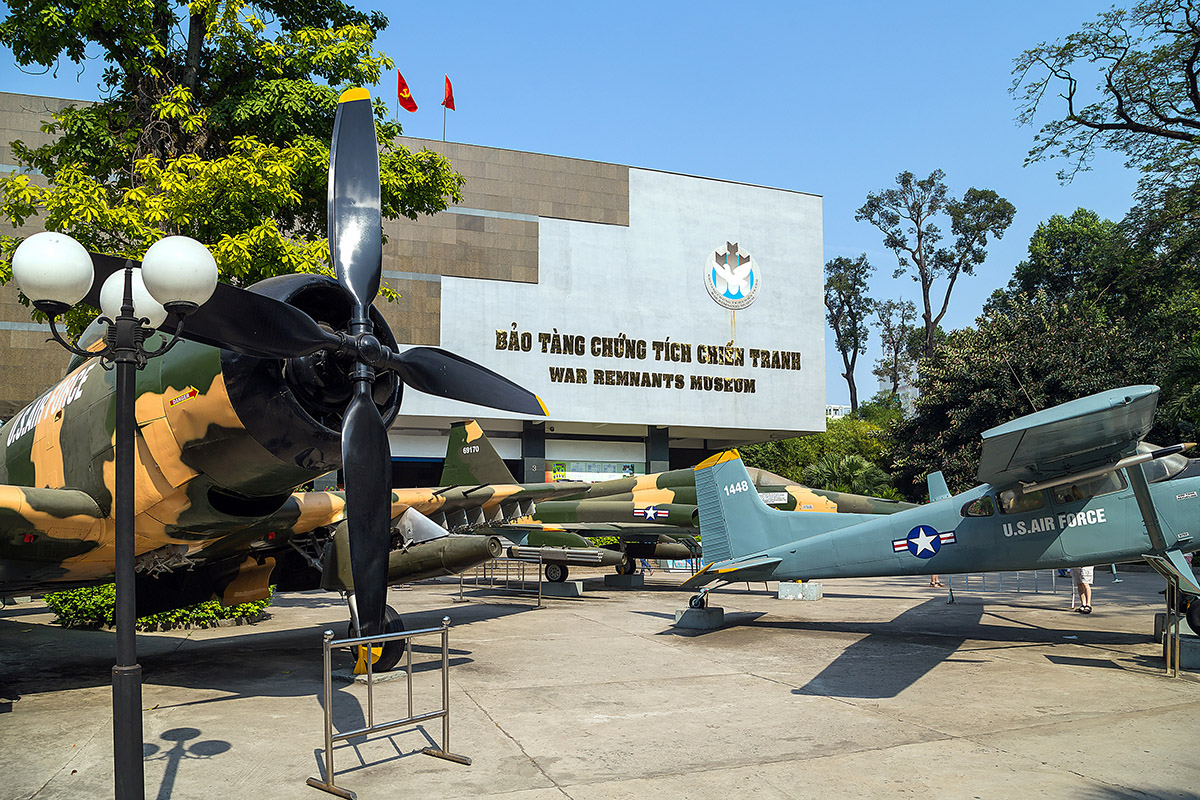For many years, helicopters have been an essential component of contemporary U.S. military operations. They perform various tasks on the battlefield and provide vital air support and troop and material mobility. Do you know that there are many different types of helicopters, each with its own specific use?
Come along as we examine the many kinds of helicopters and learn what makes them unique, whether you’re an enthusiast or just curious about these amazing vehicles.
In this article:
8 Military Helicopters Types
Army helicopters come in 8 different types with distinct functions. Any air force must be equipped with attack, transport, observation, utility, maritime, multi-role, search and rescue, and training helicopters. The name of each type hints at its purposes, like attacking models being used for combats and ground attacks, etc.
1. Attack Helicopters
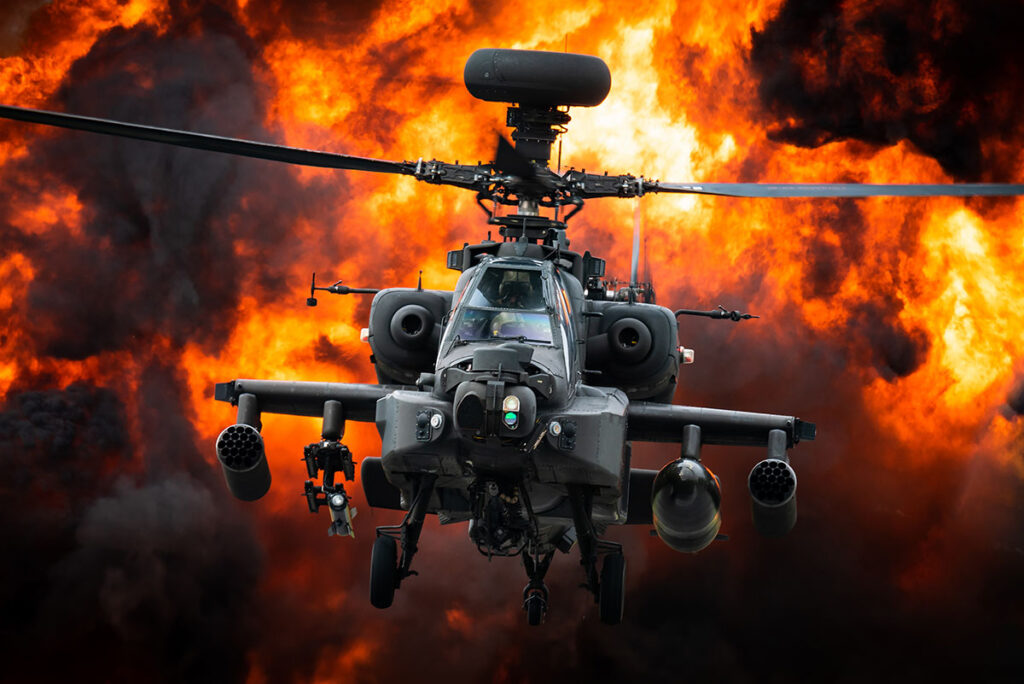
The attack helicopters, also referred to as helicopter gunships, are created for firing onto the opposition. These are equipped with machine guns, air missiles, auto-cannons, and other armament, and they may travel at great speeds in order to accomplish this goal.
Apache AH-64
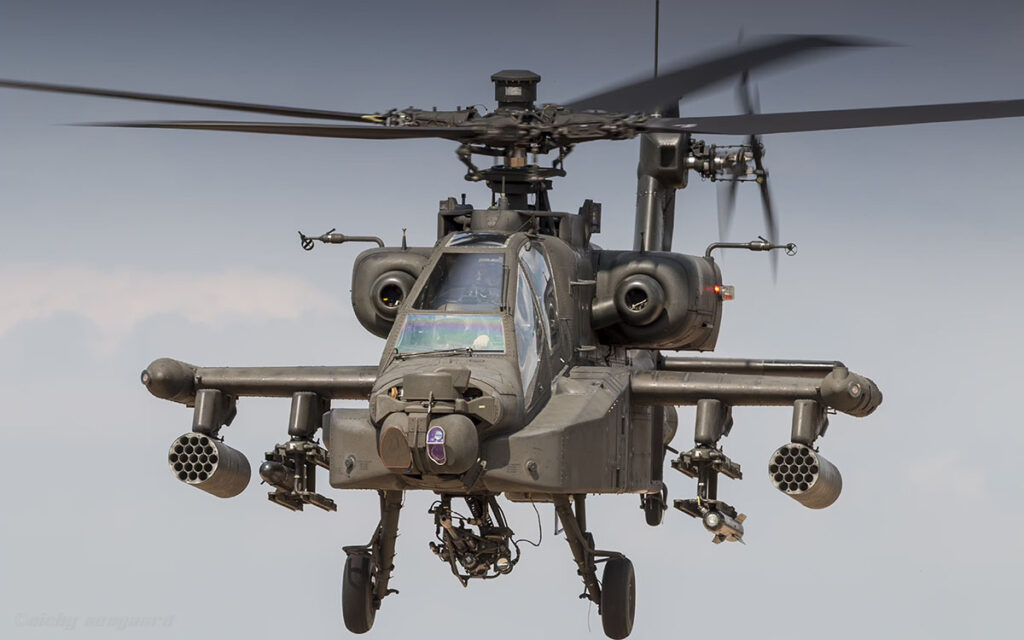
Due to its two rotors, the Boeing AH-64 Apache is a multipurpose helicopter that is easily identifiable. Its two rotors include one tail and one main, each with four blades. The best part is its nose-mounted sensors to detect targets and offer better night vision.
This combat helicopter is used by the Army for armed reconnaissance and precision attack operations in adverse weather conditions. The Apache’s enhanced lethality and survivability in combat are attributed to its superior navigation, onboard sensor suites, and avionic system.
AH-1W Super Cobra
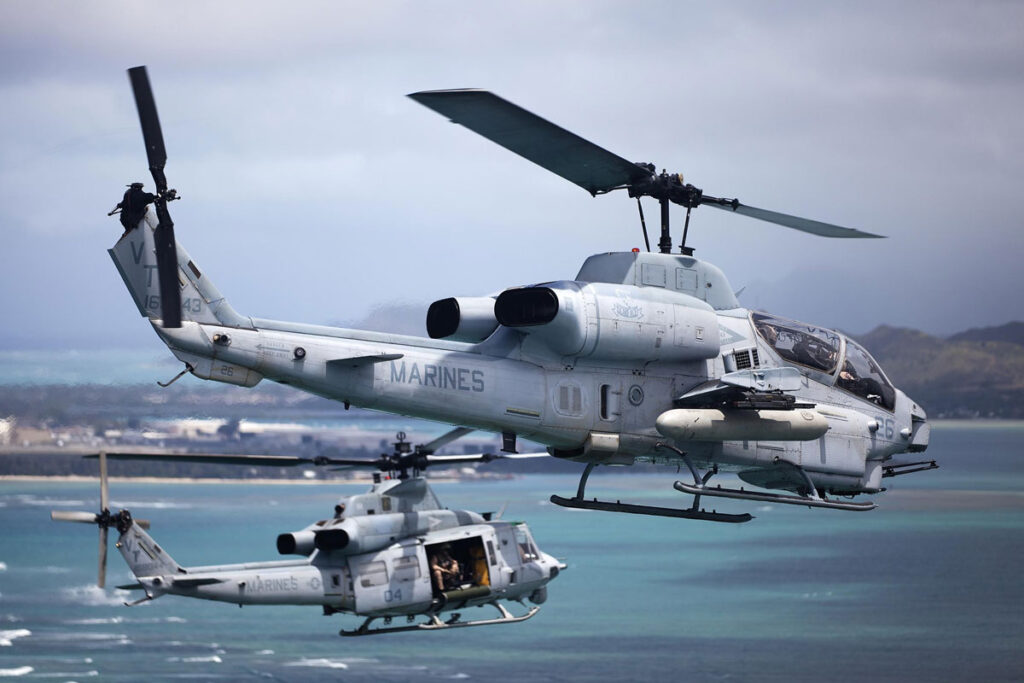
The AH-1W Super Cobra, which can also carry Hellfire missiles, was the first attack helicopter to qualify for both the air-to-air and the anti-radiation missile.
Whether supplying ground cover or escorting additional air support, the Super Cobra serves as the main assault helicopter that forms the core of the U.S. Marine Corps air-ground task force.
AH-1Z Viper
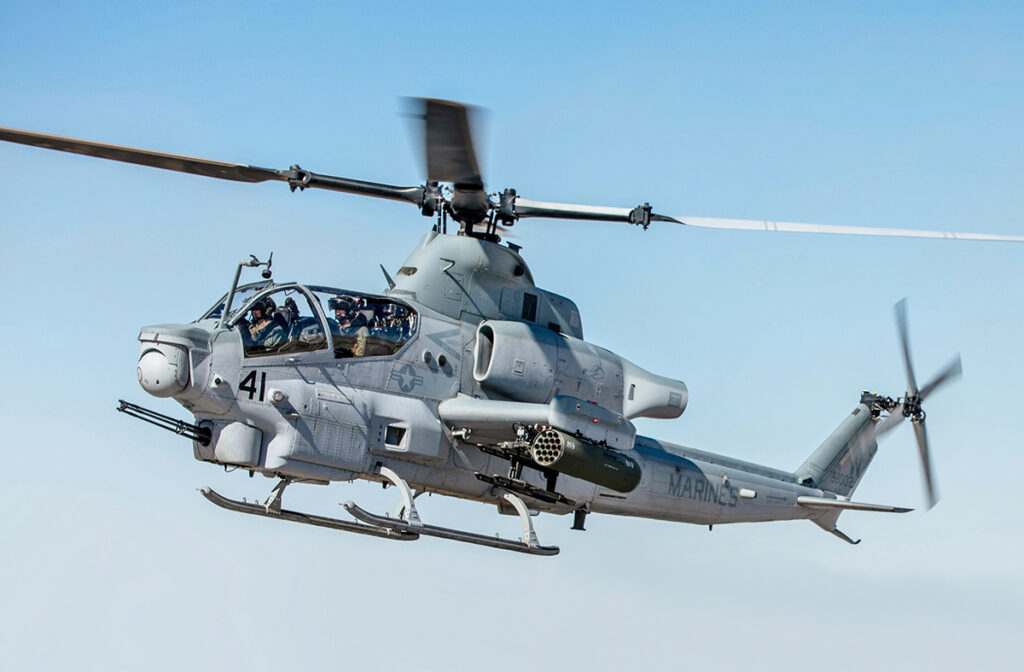
The new version of Bell AH-1Z Viper has two-engine designs. The aircraft’s revolutionary design improved stability and reduced hull vibrations by up to 70% when compared to earlier Bell Helicopter models.
It can function well in different combat situations, thanks to its sophisticated armament systems, high-tech electro-optical sensors, and advanced built-in weapon system. Given the severe demands of contemporary combat, its two-engine configuration provides more power and dependability.
2. Transport Helicopters
Due to its ability to land and take off quickly, even without a runway, large-sized transport helicopters are extremely important in the U.S. Air Force.
Alternatively, if the weather prevents the chopper from touching down, it can hover while rapidly loaded with people or supplies using rescue hoists or specialist rope lines.
Sikorsky CH-53K
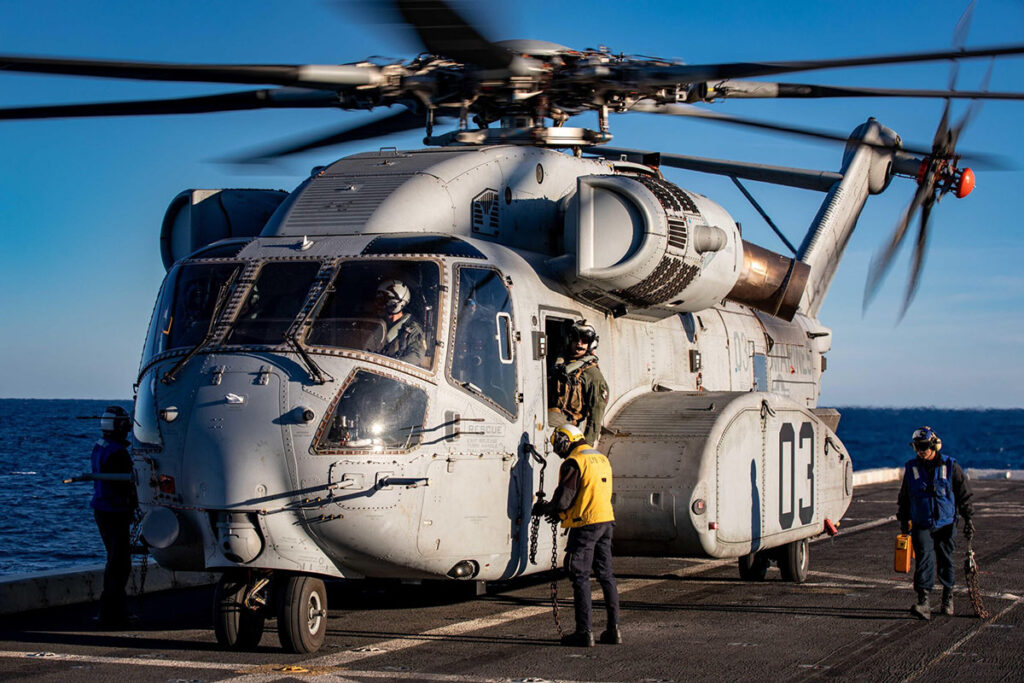
The CH-53K is the best option for moving more soldiers or goods with fewer flights, thanks to its bigger cabin and external lift capabilities. The wider cabin can accommodate HMMWVs (High-Mobility Multipurpose Wheeled Vehicles).
This allows for variable configurations for optimal mission effectiveness and makes cargo loading and unloading easier by avoiding the need to rearrange or remove troop seats. It can also accommodate 463L master pallets, which is quite an impressive loading capacity.
Bell V-280 Valor
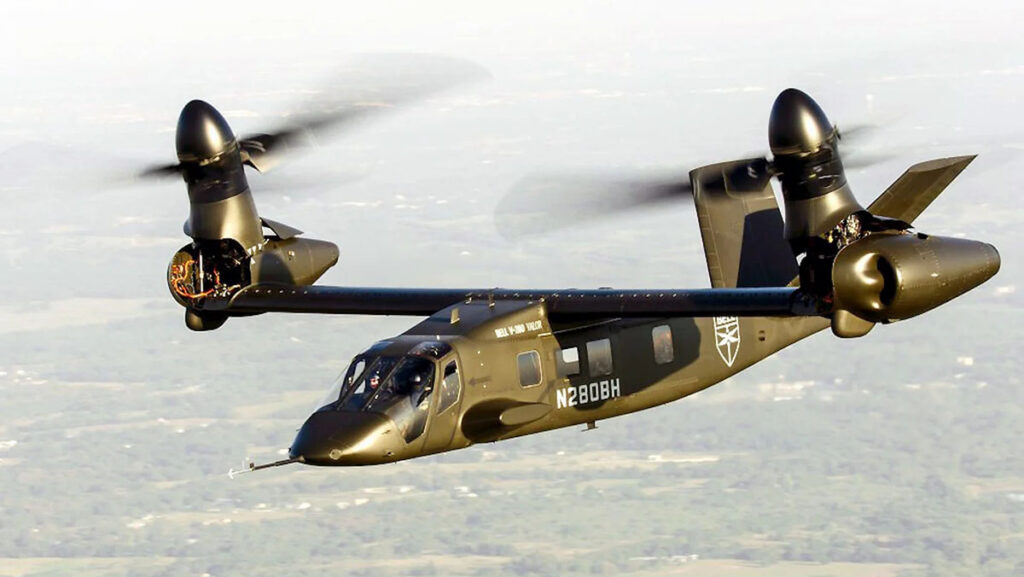
The Bell V-280 can carry up to 14 troops and is intended to operate with a four-person crew. With an MTOW of 30,865 pounds, it can lift up to 10,000 pounds (an M777A2 Howitzer) while cruising at 170 mph.
The operation of a tiltrotor aircraft is distinct as the engines stay in place. Meanwhile, the rotor and driving shafts tilt. The aircraft has a 2,100 NM ferry range, which is equivalent to 2,400 miles, and was designed to improve mission safety.
CH-53E Super Stallion
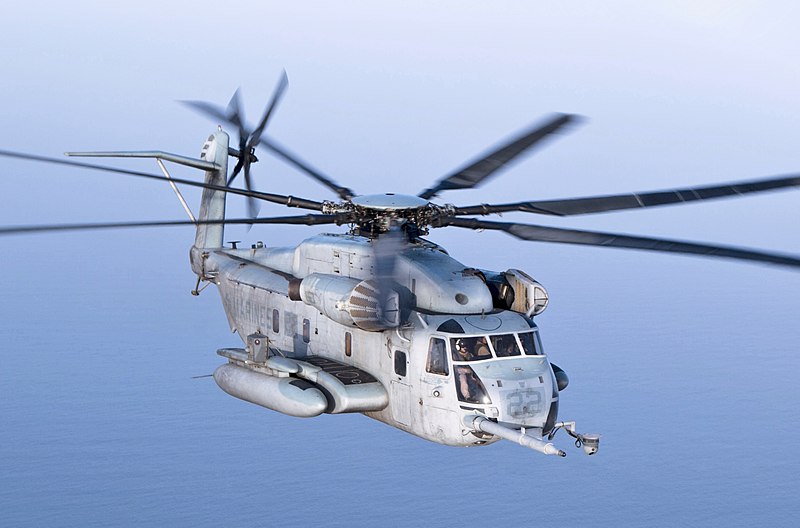
The Super Stallion is a noteworthy equipment transport helicopter that is well-known for its work in maintaining international relations and peace. This one is also the heaviest heavy-lift transport helicopter that served in the U.S. Army Force.
The Marine Corps was the target audience for the Super Stallion. This larger helicopter can transport an amazing 73,500 pounds of external cargo and has a primary rotor with seven blades.
3. Observation Helicopters
The military used flying objects only for reconnaissance roles before the development of armed aircraft. Because they can land and take off rapidly, as well as stay in one place for extended periods of time, observation helicopters are becoming the most practical option for surveillance missions.
Specialized equipment, including low-light television, lasers, and infrared cameras, are fixed to the outside frame of observation helicopters.
MH-6 Little Bird
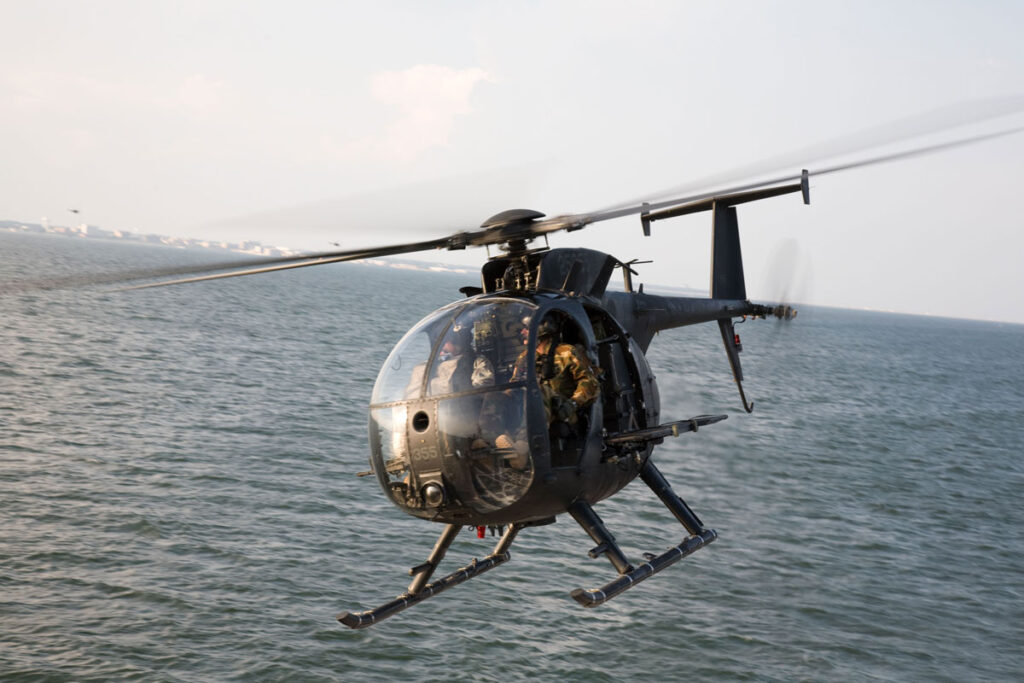
The Little Bird, in contrast to many military aircraft, can be easily disassembled, flown by cargo plane, and quickly reassembled when it reaches its destination.
Plus, this MH-6 also comes with many cutting-edge digital cockpit technologies, such as sensors, control units, navigation, and night vision. It has undergone significant modifications to include advanced avionics systems, mounted specialist equipment, and weapons system requirements.
Bell H-13 Sioux
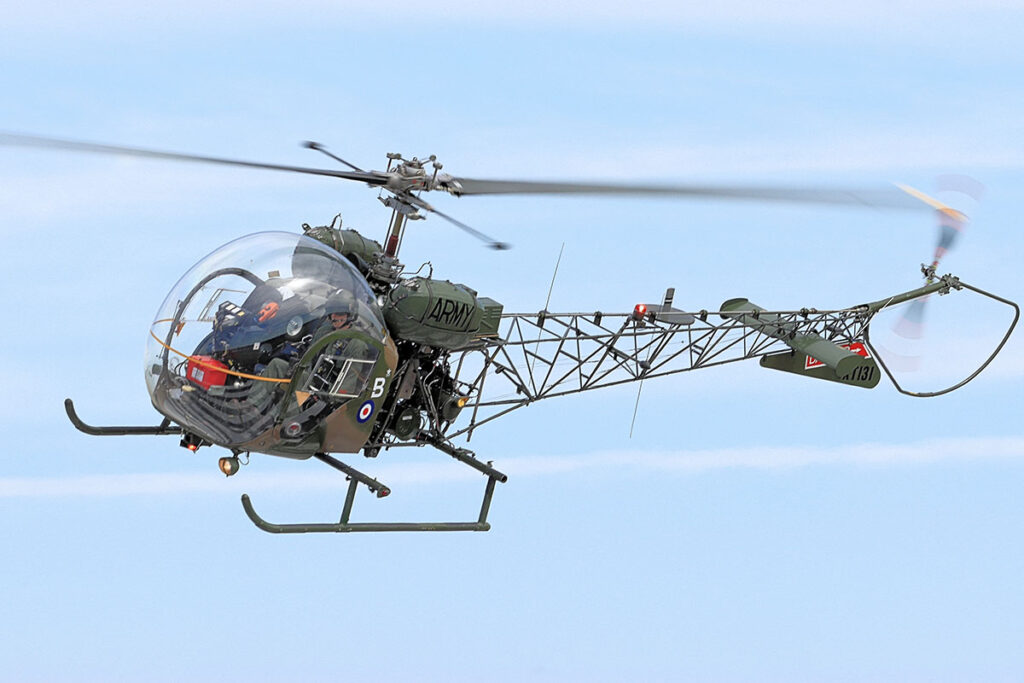
The Sioux is an observation helicopter with a three-seat design. The notable features of this aircraft include the saddle fuel tanks, bubble canopy, and skid landing gear. It has played a crucial role in the development of helicopter medical evacuation, saving many lives by quickly transferring injured soldiers to hospitals.
To hide the patients from the wind, the H-13 military versions were frequently fitted with one medical evacuation pannier for each skid.
OH-58 Kiowa Warrior
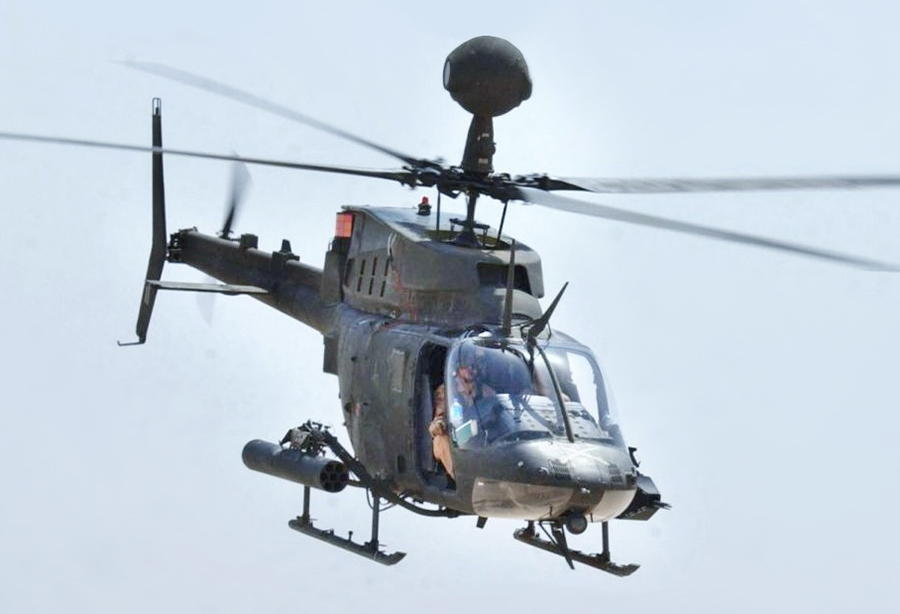
The OH-58 Kiowa Warrior is a reconnaissance helicopter with four blades and a single engine. It is equipped with modern weaponry and cockpit interaction systems, making it an extremely effective observation helicopter.
The U.S. Army uses the Kiowa mainly as a target air combat mission helicopter. Within minutes of arriving, the Kiowa may be fully operational and quickly deployed.
4. Utility Helicopters
Utility helicopters are a type of very adaptable aircraft that perform well in any kind of setting. Because of their agility and dexterity, these helicopters can fly in tight locations and carry out precise maneuvers while on multiple tasks.
Plus, they can be outfitted with specialist mission equipment such as firefighting buckets, cargo hooks, medical evacuation kits, and rescue hoists to meet certain operating needs. Some of the missions may include evacuation and transport, as well as surveillance and assault.
Sikorsky UH-60 Black Hawk
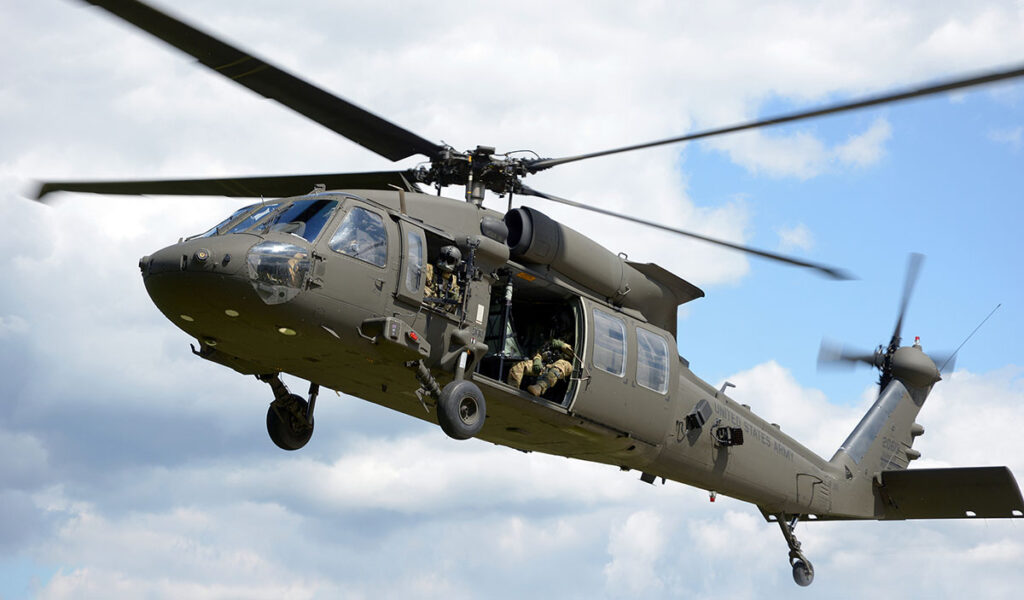
The Black Hawk is an air assault and tactical transport helicopter used by the United States Army. This helicopter can accommodate 11 well-equipped troops, carry 2,600 pounds of internal cargo, or lift up to 9,000 pounds externally.
The Black Hawk has a landing gear arrangement with dragging tail wheels. This military chopper is capable of operating in any weather. It is possible to equip the Black Hawk with landing skis for use in cold conditions.
UH-1Y Venom
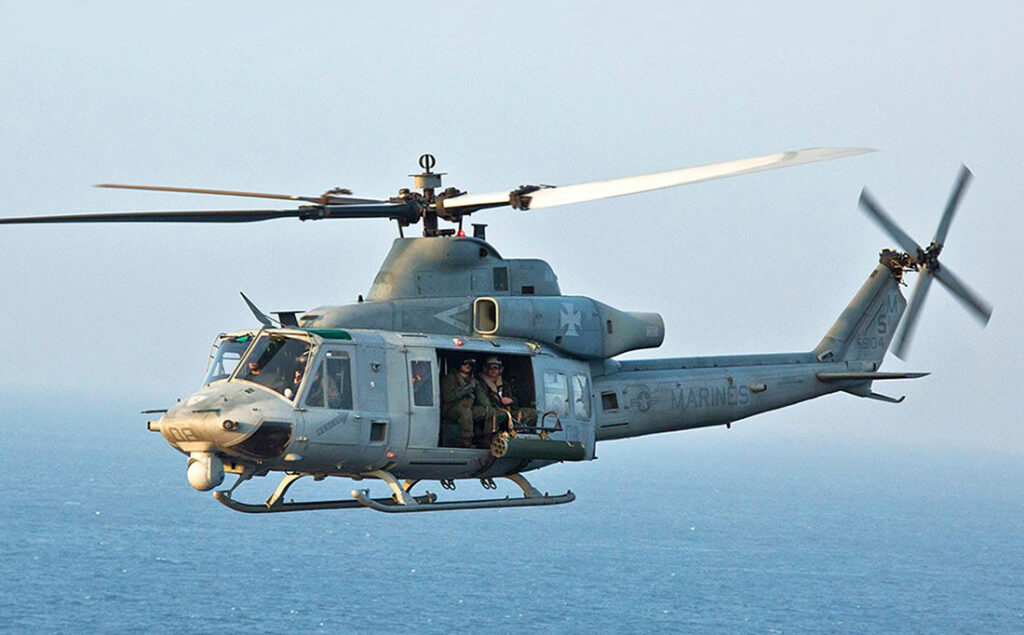
This military aircraft has an all-composite rotor system with four blades that can withstand ballistic forces, and it has two turboshaft engines. With an increased range and a 50% boost in payload, the UH-1Y Venom is an armed aircraft with increased survivability and cargo-carrying capacity.
During the day, at night, and in inclement weather, the UH-1Y is used for assault support, command, and control.
Bell UH-1N Iroquois
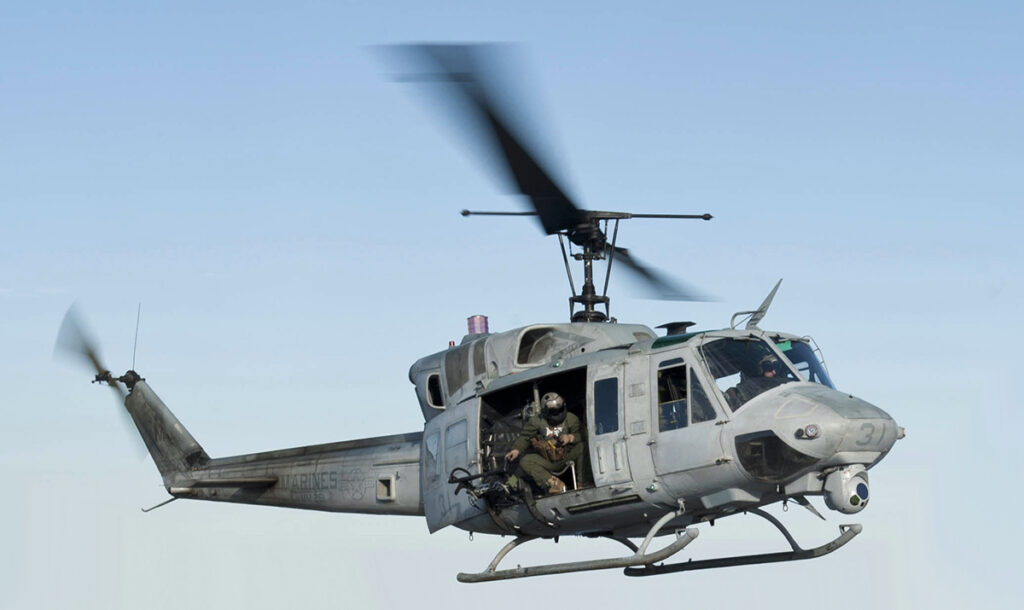
The UH-1N Iroquois is a light-lift utility helicopter powered by a single engine with two blades on its tail and main rotors. It is employed to serve a variety of operations.
The three main missions are the airlift of security troops, the protection and monitoring of nuclear weapons convoys that leave the facility, and the airlift of notable visitors.
5. Maritime Helicopters
Military marine helicopters are made expressly to operate in submarine and over-the-water conditions. They are equipped with characteristics like flotation devices, corrosion-resistant materials, and the capacity to function from naval platforms or ships. They are essential to surface surveillance, maritime patrol, search and rescue, and anti-submarine warfare.
MH-60R Seahawk
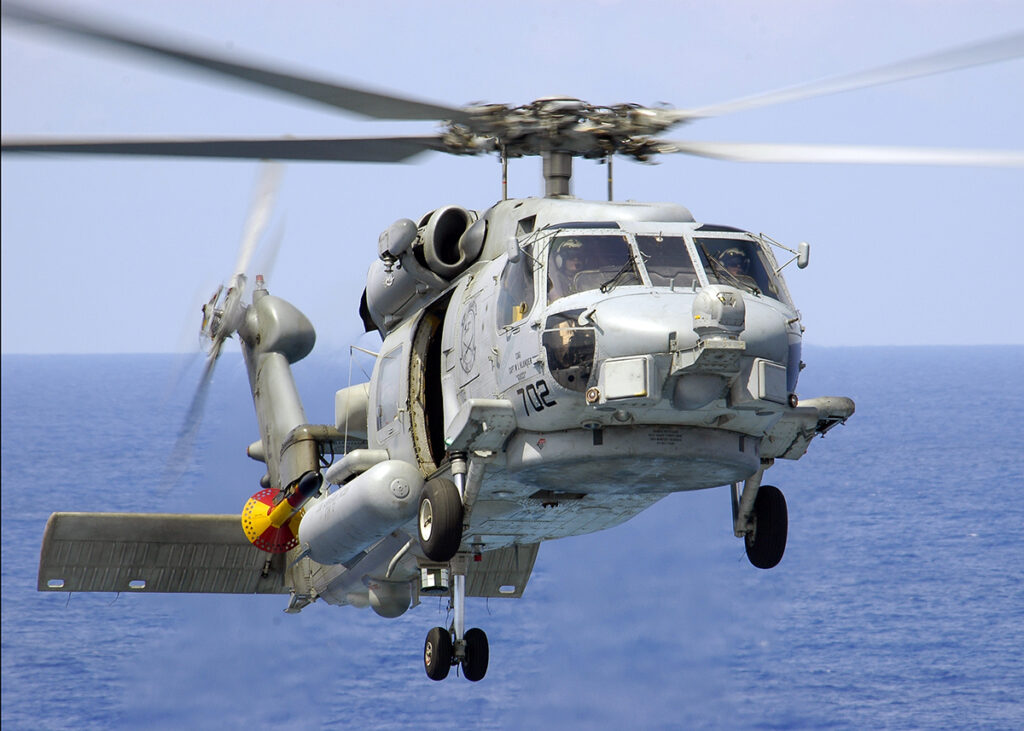
With its unique design for all land and maritime missions from any air-capable vessel, the MH-60R serves as the main surface warfare and anti-submarine helicopter of the United States Navy.
Since reaching its optimal operational capability in 2010, the MH-60R has shown to have unparalleled multi-mission capabilities, attaining the greatest mission-competent rates of any marine helicopter on record.
AgustaWestland AW101
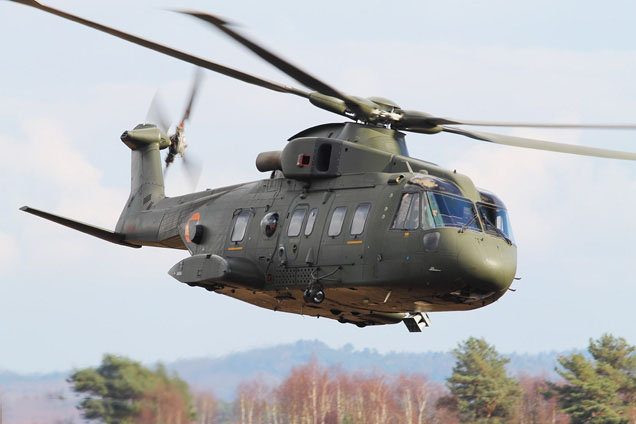
To guarantee the completion of all types of marine missions, the AW101 combines cutting-edge design and advanced technology with great range and endurance. Operators may adapt the AW101 platform for various duties, such as maritime, battlefield recovery, and search and rescue (SAR), because of its versatility and the entire suite of onboard equipment.
The AW101’s cabin capacity enables it to transport up to 38 troops with minimal equipment, 16 wounded stretchers, or vehicles like tactical ATVs and quad bikes.
Sikorsky SH-3 Sea King
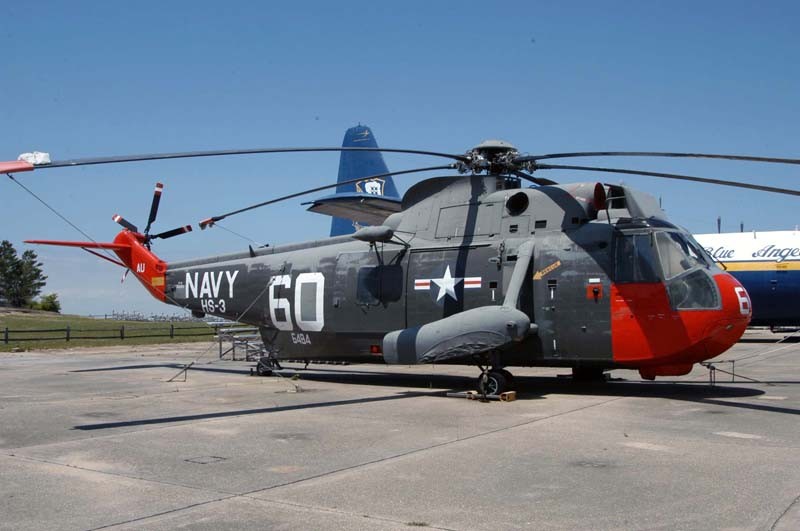
The Sea King combined the responsibilities of killer and hunter, traditionally performed by two different helicopters, by carrying 4 torpedoes and advanced sonar detecting technology. In addition, the helicopter carried out anti-shipping, transport, and warning operations.
As plane guards, aircraft carriers would send out the Sea Kings to save crew members who crashed during landing or takeoff.
6. Multi-Role Helicopters
Military helicopters with multiple roles are adaptable aircraft that can carry out varied tasks and adjust to differing operational demands. They combine the ability to transfer with the ability to attack or monitor, making them well-suited for a wide range of jobs.
They provide flexibility and cost-effectiveness because they eliminate the need for customized platforms for every operation.
UH-72A Lakota
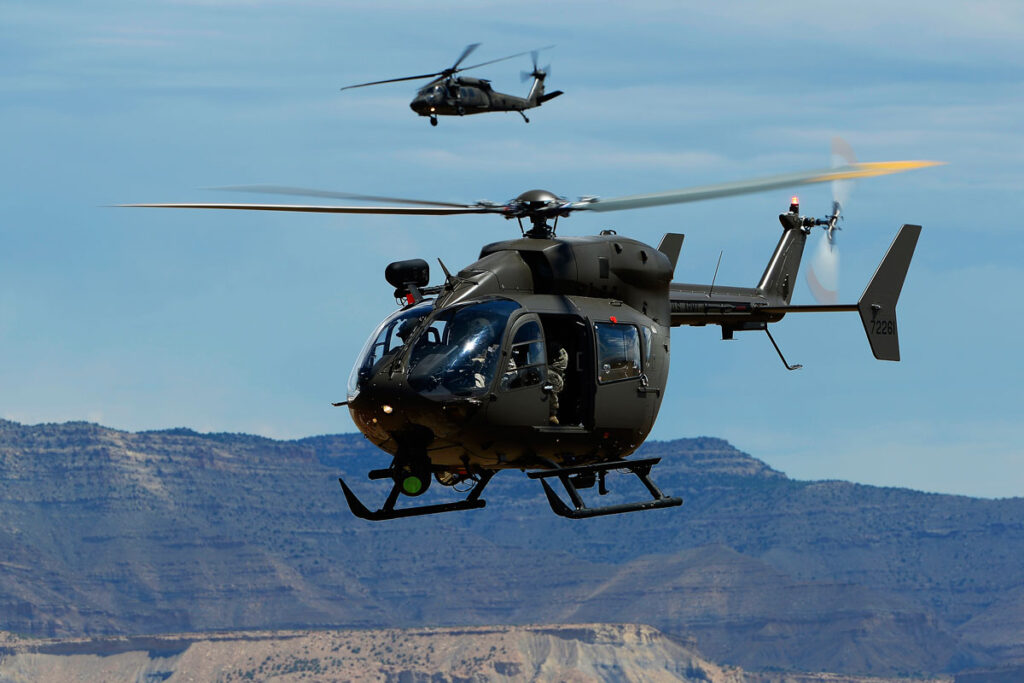
The UH-72A Lakota is a type of light-duty helicopter with two engines. It has one main rotor with four blades and one tail rotor with two blades, both on the left side of its tail assembly.
The tail rotor is essentially boxed in by two additional vertical stabilizers that are placed on the outside borders of the stabilizers, allowing the cargo compartment to be loaded and unloaded safely.
MH-60 Jayhawk
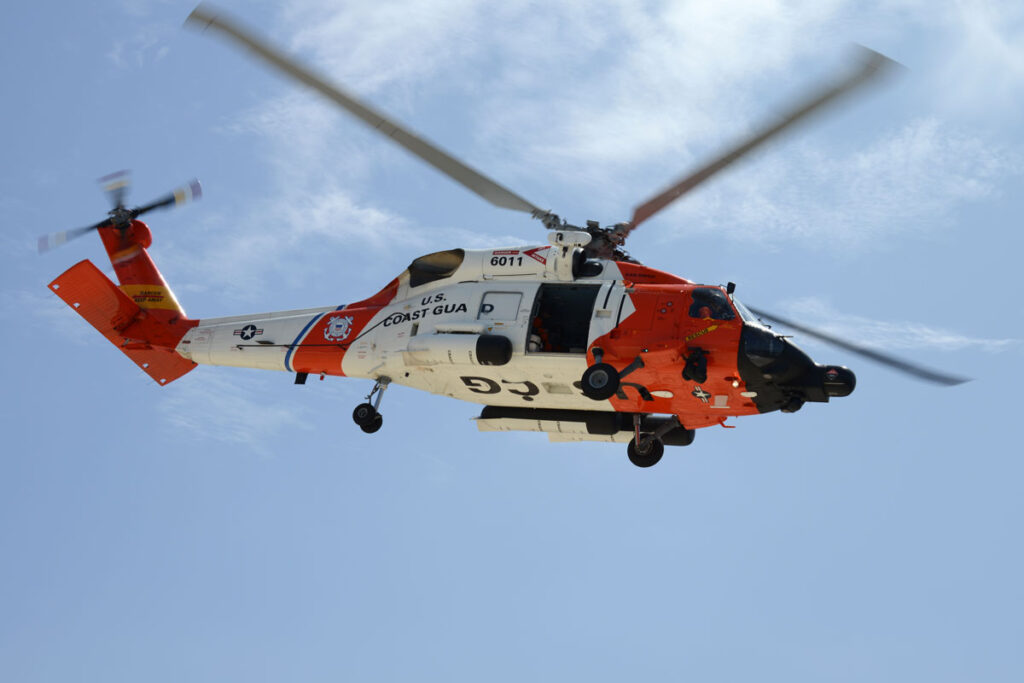
This one is one of the favorite multi-role aircraft of the Coast Guard. Based on the Black Hawk helicopter used by the Army, Sikorsky manufactures the MH-60 Jayhawk, a medium-range, two-engine helicopter that completes many types of missions.
The U.S. Coast Guard uses this machine in all-weather situations for law enforcement, maritime narcotics interdiction, military preparedness, rescuing, and protecting marine environment.
V-22 Osprey
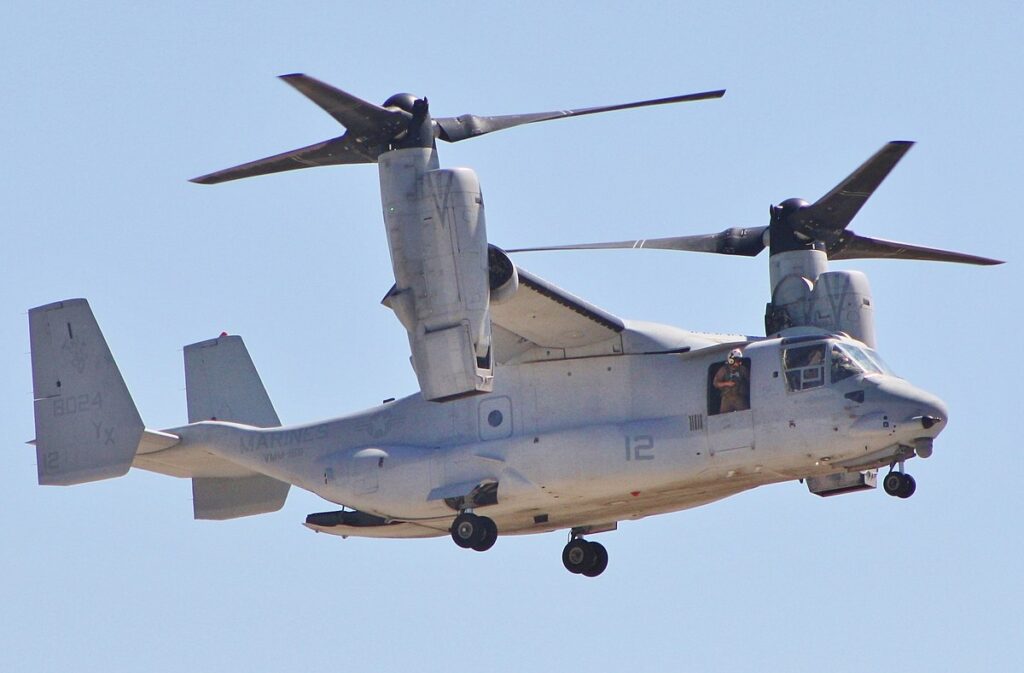
The Osprey can take off quickly like a helicopter and can fly faster than a helicopter. It can fly like a helicopter and hover in a vertical position. After taking off, it may transform into a turboprop aircraft traveling at high speeds and altitudes.
Its speed exceeds that of a traditional helicopter, which comes in third on this list. Bell and Boeing collaborated on its development. Despite its speed, it is a rather large vessel.
7. Search And Rescue Mission Helicopters
Helicopters used for search and rescue are committed to rescuing lives in dire circumstances. They can identify and rescue injured or trapped people because they are equipped with specialist equipment, including medical facilities and hoists.
Sikorsky HH-60G
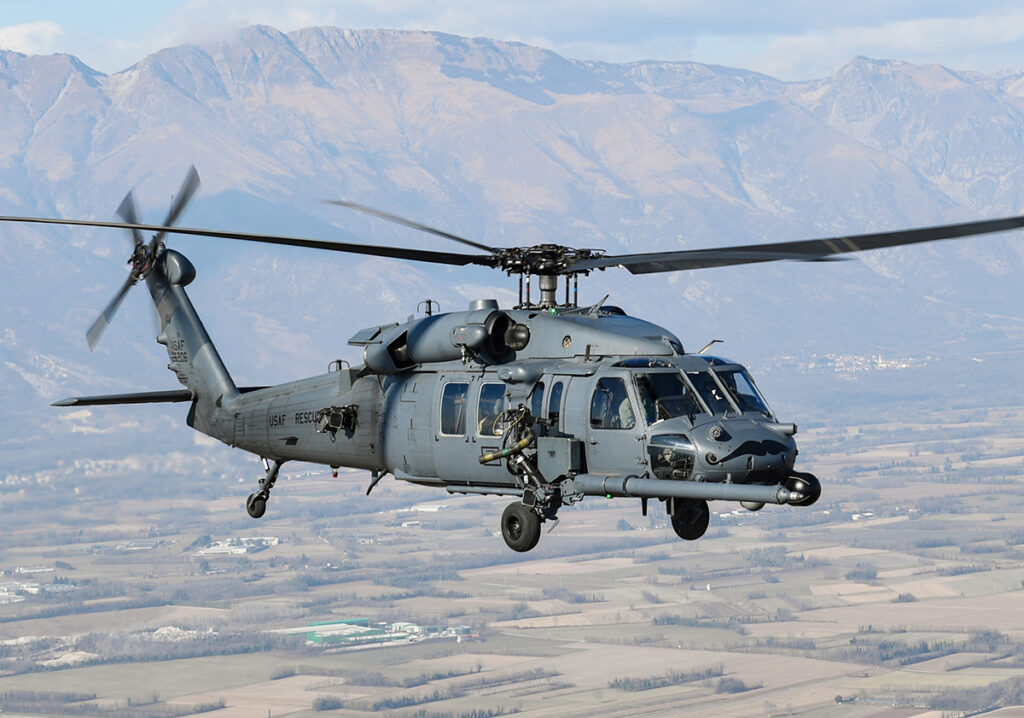
The two turboshaft Electric T700-GE-701C engines power the HH-60G, allowing it to achieve a maximum power output of 1,220kW apiece. The engine’s configuration includes six stages of compression, an annular combustor, a two-stage low-pressure gas generator, and a dual-stage high-pressure turbine.
The nighttime low-level operations of all HH-60Gs are substantially improved by their autonomous flight control system, forward-looking infrared system, and night vision goggles lighting.
MH-65 Dolphin
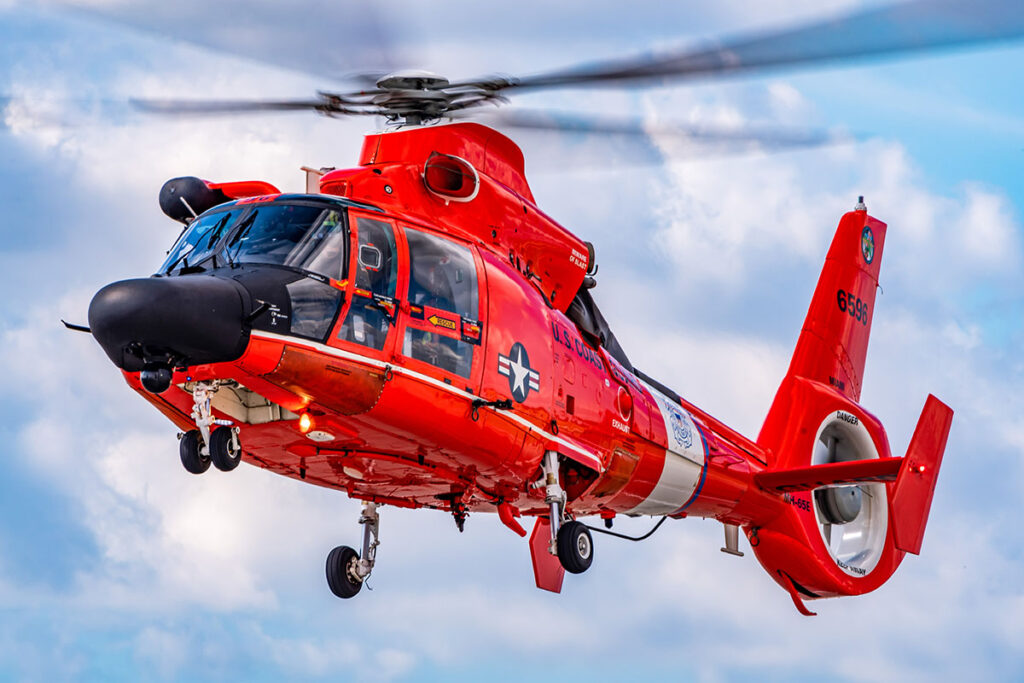
The MH-65 Dolphin is the main rescue helicopter used by the U.S. Coast Guard. It is approved for use in all-weather situations, including at night, except in ice conditions.
Recent major enhancements to the MH-65 included replacing outdated parts and improving the communications package as part of a conversion-sustainment program.
8. Training Helicopters
Pilots may hone their skills and acquire new ones on military training helicopters, which are made especially for this purpose. Their complex flying systems, dual controls, and simulation capabilities allow them to mimic real-world situations. In addition to advanced flying instruction and tactical maneuver practice, these helicopters are utilized for new pilot training.
Bell TH-67 Creek
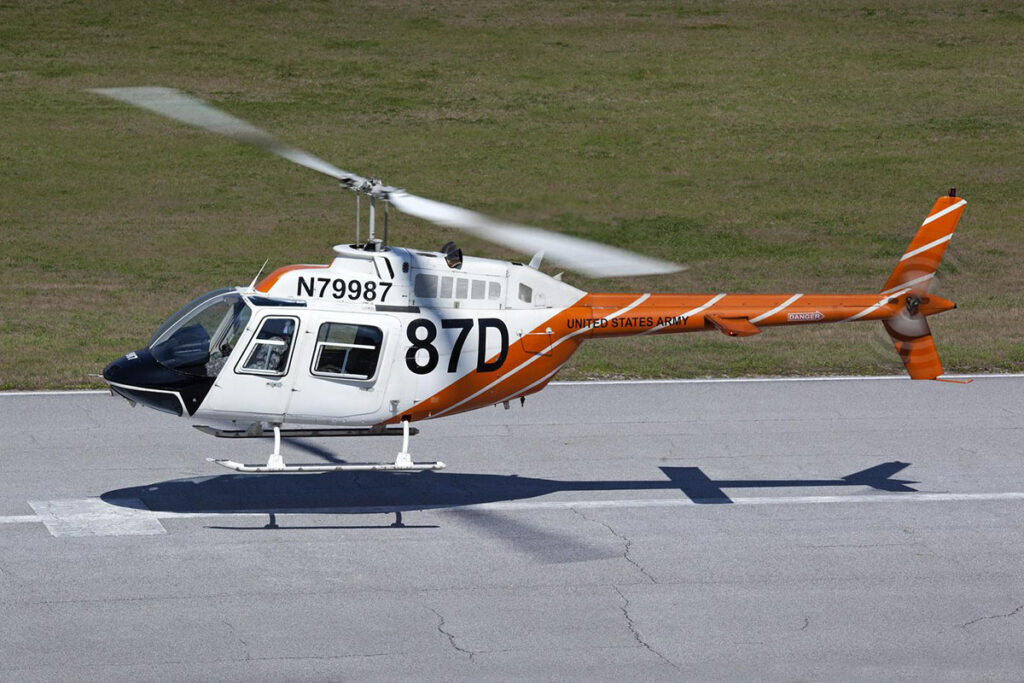
The TH-67 Creek is equipped with a single engine for instrument proficiency training. Pilots may perform more difficult flying maneuvers with ease because of the helicopter’s modern avionics, which include an autopilot system and a Rolls-Royce 250-C20W engine.
TH-67s have served the Army since 1993 and retired in 2020, clocking in over 1.9 million hours and training 25,000+ students.
Eurocopter EC635
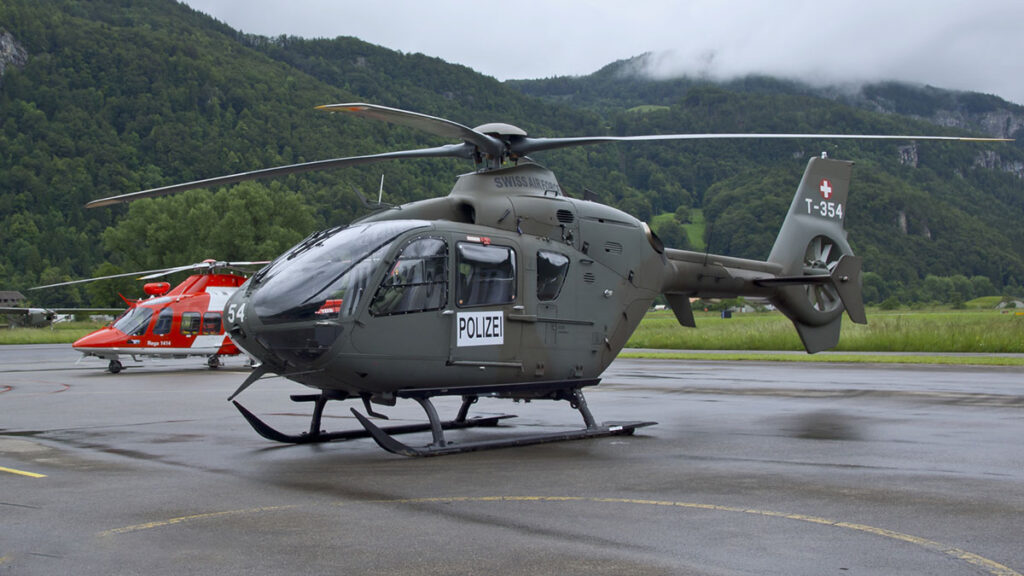
The Eurocopter EC 635 is a military aircraft that builds upon its predecessor, the EC 135, and is capable of towing weaponry. The engines drive a four-bladed, fiber-reinforced composite BMR (which stands for Bearingless Main Rotor) and the well-known Fenestron tail rotor, both of which lower noise and vibration levels.
Notably, the Troop Transport variant may be equipped with passenger seats to accommodate 1 pilot and 6 passengers, or utility seats to accommodate 1 pilot and 7 troops.
TH-57 Sea Ranger
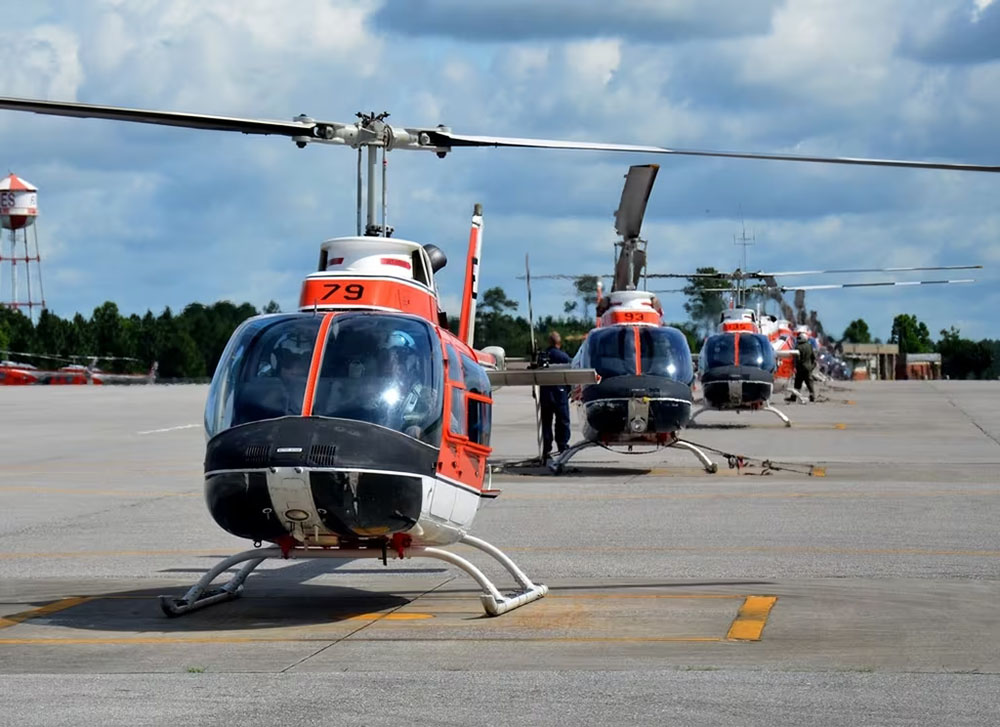
These aircraft are utilized for utility, pursuit, and photography missions in addition to their primary purpose of training. The TH-57 is a turbine-powered, single-engine helicopter with a two-bladed tail rotor and four-bladed main rotor. This aircraft can hold up to five persons, including the pilot, teacher, and three passengers, making it great for training.
What Are The Technologies Used In Military Helicopters?
Cutting-Edge Avionics
Most modern military helicopters are equipped with superior avionics, such as digital instrumentation, glass cockpit displays, and integrated flight control systems. These helicopter technologies simplify information management, improve fly control, and increase pilot situational awareness.
Guns And Aiming Devices
Military helicopters are technical marvels of the contemporary day, fusing cutting-edge technologies to provide unmatched combat capabilities. Therefore, guns and aiming devices are indispensable.
Precision-guided missiles, rockets, and gun systems are just a few of the cutting-edge armaments and targeting systems used on these aircraft. These technologies enhance damage to armored vehicles or hostile positions while enabling precise target engagement. Targeting systems and night vision technologies also improve aircraft performance in low-light or evening operations.
Stealth And Resilience Improvements
When operating in dangerous settings, military helicopters need to improve their survivability and stealth. To reduce detection by adversary radar systems, these improvements include stealthy material incorporation and fuselage shape as methods of reducing radar cross-section.
To repel approaching threats and missiles, helicopters are also outfitted with defensive countermeasures, including chaff, flares, and electronic warfare equipment.
Rotor And Engine Technologies
Military helicopter performance and economy have increased dramatically due to advancements in rotor and engine technology. Modern technologies continue to improve power, fuel economy, and dependability.
For example, new rotor designs, such as composite materials, have enhanced overall performance by improving stability and reducing vibration.
See more:
The Bottom Line
Helicopters are among the world’s most adaptable and flexible weaponry, crucial in both times of peace and conflict. There are several categories of military helicopters. Every kind serves a certain subset of tasks across a broad range of military missions.
Now you know the eight main types of military helicopters and even learn about some of the most common military helicopter names of each category. These aerial vehicles exhibit remarkable engineering achievements essential to preserving national security. Such fascinating machines, right?

